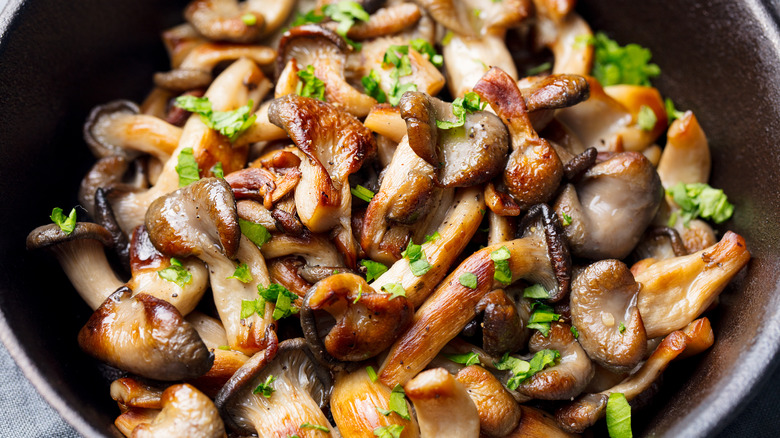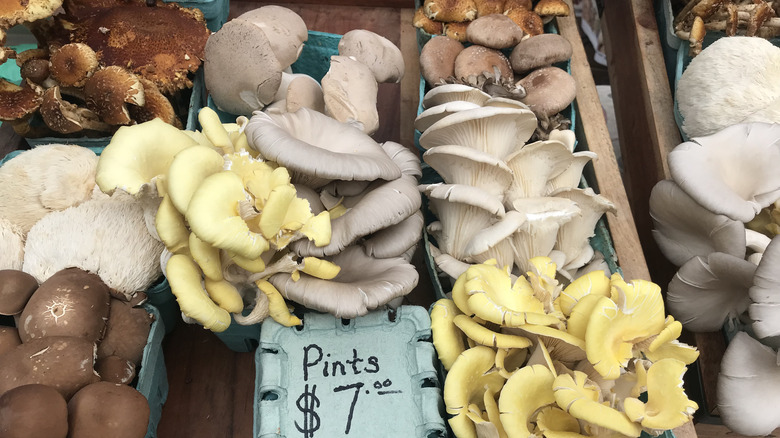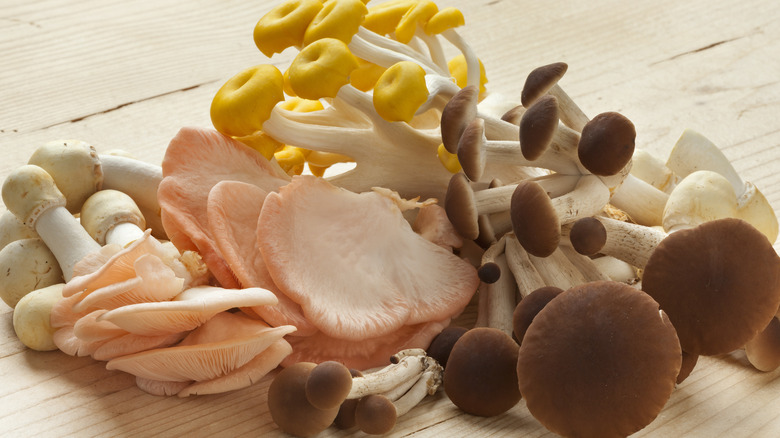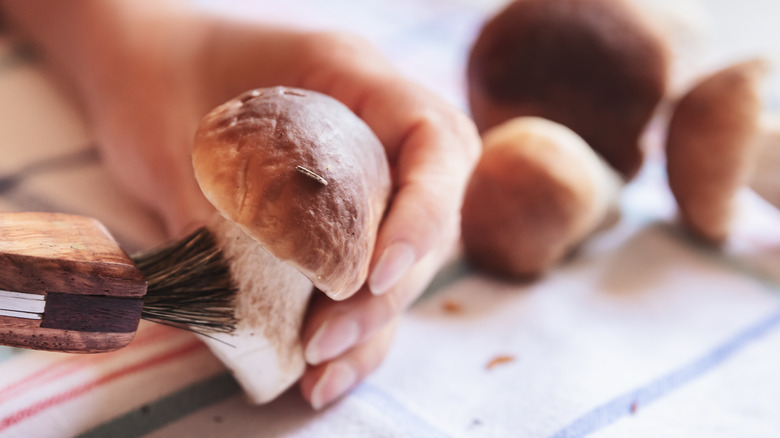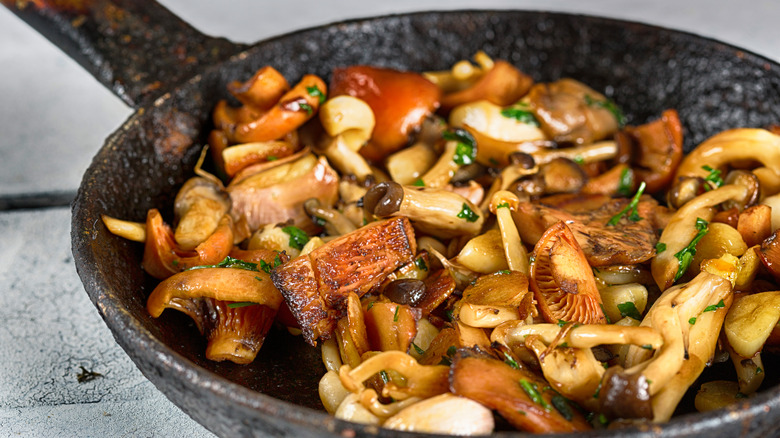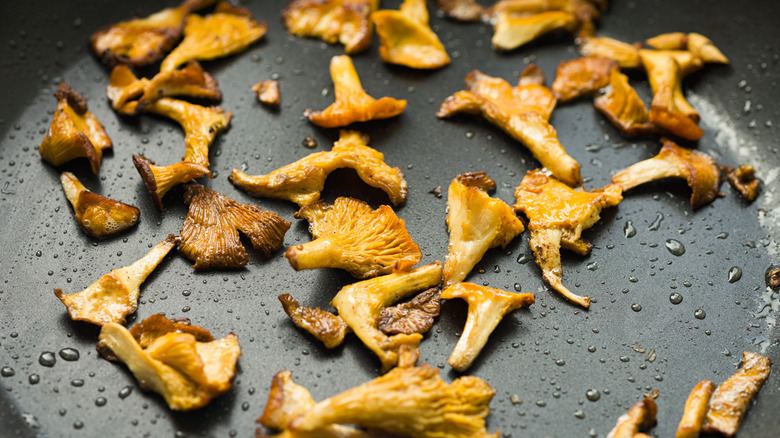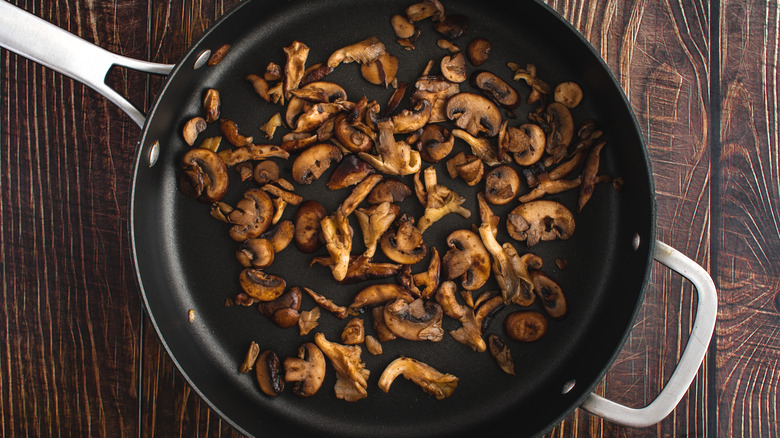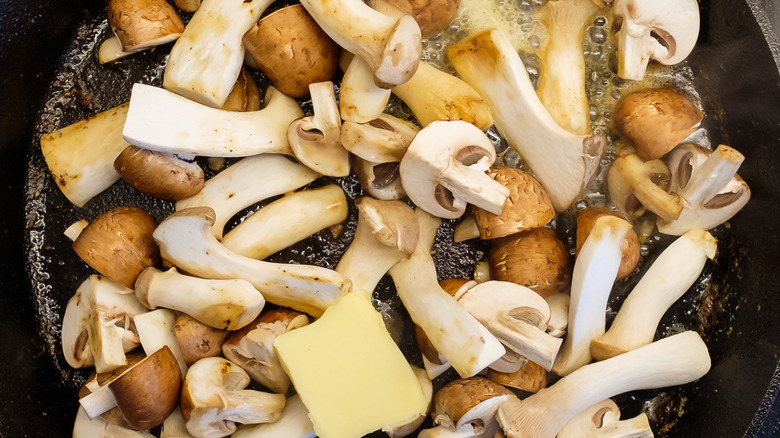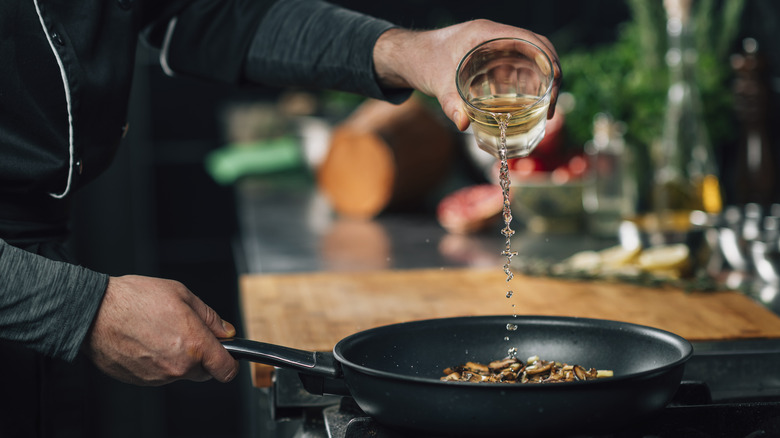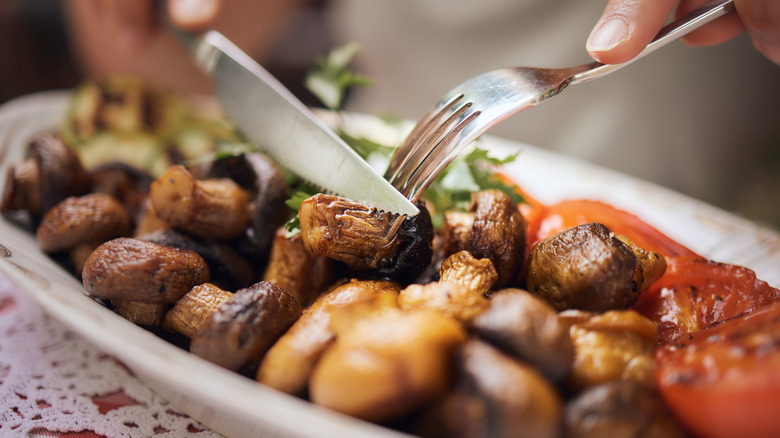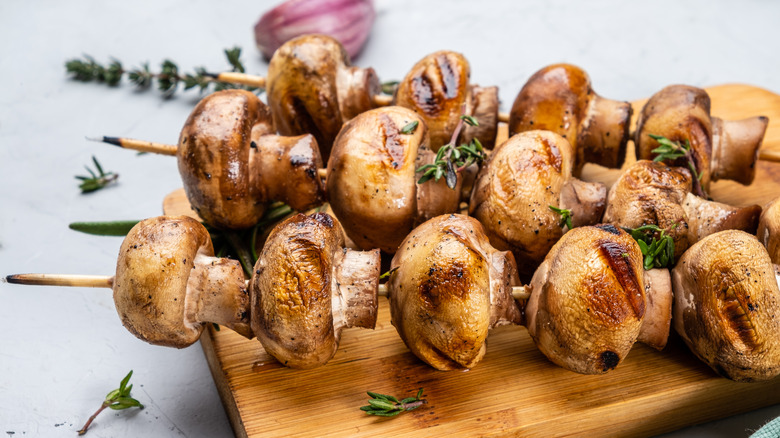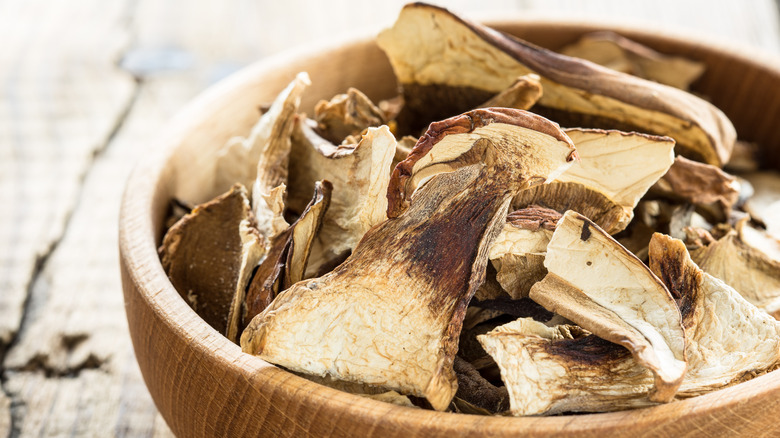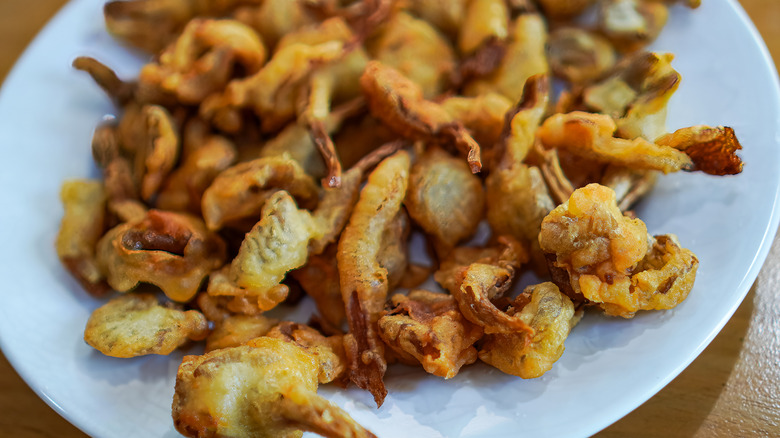Chefs Reveal Why Mushrooms Taste Better At A Restaurant Than At Home
If you've ever gone to a restaurant and ordered mushrooms, you know that they can taste divine. Succulent, flavorful, and chewy, perfectly cooked mushrooms are a delicacy on par with the finest seafood or steak. Beyond common varieties like white button and portobello, mushrooms come in all shapes and sizes, lending diverse flavors to pasta dishes, soups, salads, and more. Mushrooms are the perfect complement to steak or chicken, but they're also delicious in their own right. They even work well as meat alternatives, thanks to their versatility and umami-rich depth of flavor.
Trying to capture the magic of your favorite restaurant mushroom dishes at home can be tricky. Perfecting the texture and flavor might require a bit of experimentation. Many people might even feel too intimidated to try cooking with mushrooms at all. Recognizing the challenges many face with preparing mushrooms, we consulted several experts to help home cooks feel more confident in the kitchen. These experts shared valuable insights on prepping and cooking mushrooms to achieve delicious, restaurant-worthy results.
Restaurants source the freshest mushrooms
Restaurants tend to use the freshest produce, which is extra crucial when it comes to mushrooms. Experts say to make sure mushrooms are firm to the touch. "Mushrooms should not be mushy, no pun intended," says Helene Henderson, chef and founder of Malibu Farm. Look for mushrooms that are dry 一 sliminess is a sign they're past their prime. Since mushrooms have a short shelf life, prioritizing freshness is key to enjoying the full range of flavors and textures they have to offer.
The farmer's market is a great place to buy fresh mushrooms, especially lion's mane, maitake, oyster, and other varieties that grocery stores might not stock. Amanda Janney, mushroom farmer and founder of KM Mushrooms, explains, "A great perk of the farmer's market is selection, and you can directly ask the farmer when the mushrooms were harvested! Locally grown mushrooms are very likely organically produced." Outside of farmer's markets, specialty grocery stores or local produce markets are your best bet. Make sure to store mushrooms in the fridge and use them within several days of purchasing.
Restaurants cook with different varieties
Many home chefs are likely missing out on the incredible diversity that exists with mushrooms. "I think this can be attributed to the fact that (in general) Americans are rather mycophobic," says Janney. "There is definitely a strong, growing interest in specialty mushrooms (oysters, lion's mane, shiitake, pioppino, etc.) that is helping to shift the sentiment towards mushrooms. Luckily, specialty mushrooms offer a more flavorful and better texture than common Agaricus bisporus mushrooms."
Most grocery stores only carry white button, cremini, and portobello mushrooms 一 which are actually the same mushroom (Agaricus bisporus) at different stages of its life. So, anyone who dislikes mushrooms may simply not be a fan of Agaricus bisporus. Luckily, mushrooms can range wildly in taste and texture. James Beard Award-winning chef Galen Zamarra favors morels, a type of wild mushroom that doesn't grow on farms. "I love stuffing them and roasting them whole. Having said that, they are harder to get and more expensive," he says.
Pioppino and chestnut mushrooms have deliciously nutty flavors, making them well-suited to soups and stews, according to Janney. Shiitake are known for their bold umami flavor, oysters have a delicate taste and texture, and enoki are mildly sweet. With so much variety, you really can't go wrong experimenting with different types of mushrooms.
Chefs prep them carefully
Chances are you've been cleaning your mushrooms incorrectly. Most experts recommend not washing them with water. "[T]hey will absorb too much water and then no matter what just steam and be soggy and watered down in flavor," Zamarra explains, recommending a soft-bristled brush instead. If you must use water, immediately place them on a rack with towels and let them dry.
Vincenzo Della Polla, Executive Chef and Cooking School Instructor at Pritikin Longevity Center, also recommends brushing. "It's like mushroom meditation! Just simply take your time and clean with a gentle brush or damp cloth. Make sure they are dry before you trim the stems and chop as needed."
When it's time to prep mushrooms, Janney first cuts off any hard or rough bits. "I normally hand tear mushrooms for recipes that call for larger pieces of mushrooms as it gives a great texture. Other recipes are better suited for rough chopping or dicing. I also love to slice lengthwise and marinate mushrooms before roasting or grilling." As to what to do with mushroom stems and base trimmings, Janney suggests saving them to make a broth. You can enjoy the broth as a savory drink or use it as the base for soups or other dishes.
Restaurants season them
While mushrooms are enjoyable on their own, restaurants often elevate them further by cooking them with herbs, seasonings, and other flavorful additions. "There are so many great ways to add flavor and cook with mushrooms!" says Janney. "Everything from butter and garlic, to BBQ sauce, to miso butter can pair very well with mushrooms." Janney identifies thyme as a personal favorite herb to use, explaining that it works well with the earthy notes in mushrooms, creating a well-rounded flavor profile.
When it comes to flavoring mushrooms, the possibilities are endless. "Soy sauce and butter work great together, so does balsamic vinegar, or an aged sherry vinegar," says Zamarra. He also likes to incorporate thyme, tarragon, and aromatics like garlic, shallots, or fennel. So, the next time you cook with mushrooms, don't be afraid to experiment 一 though beginners can never go wrong with a little butter (or oil) and garlic. Use whatever you have in your fridge or pantry to bring your mushroom dish to the next level.
Chefs make sure not to overcrowd the pan
Using a pan is one of the quickest and easiest ways to cook mushrooms. However, experts agree that the biggest mistake that home chefs make is overcrowding the pan. Mushrooms contain a lot of moisture, meaning that they need enough space for the water to escape while cooking. Otherwise, they'll end up steaming. As Della Polla puts it: "[T]hey need room to breathe, it's not a mushroom mosh pit!"
To avoid overcrowding, make sure to sauté mushrooms in a large pan or skillet. If you don't have a large enough one on hand, Henderson has a solution. "I recommend using a large skillet or cooking in batches to keep your skillet no more than two-thirds full." She cooks the mushrooms on medium-high for three to five minutes.
Janney's tried-and-true method for a basic sauté involves starting with a dry pan. After the mushrooms sweat on medium-high heat for five to 10 minutes, add in your butter or oil, herbs, and spices. Cover the pan and let everything cook for 10 or so minutes. Then, stir and cook them for another few minutes uncovered. "This will crisp the underside while leaving the top softer and chewier," Janney says.
Restaurants turn up the heat
Restaurants aren't afraid of using high heat on their mushrooms. Like with overcrowding the pan, mushrooms cooked at low temperatures will steam instead of sear, missing out on that delicious browning. According to Zamarra, "This not only affects the flavor, but ends in soggy textures." He recommends using enough heat so that any water that seeps from the mushrooms quickly evaporates. If there's liquid in the pan when the mushrooms are cooking, the heat is too low.
Della Polla seconds using high heat. "Just remember: high heat for that caramelized goodness," he says. The heat caramelizes the natural sugars in the mushrooms, resulting in a rich depth of flavor and crispy texture. But before caramelization can occur, the water from the mushrooms needs to evaporate, which only high heat can accomplish. Only then will the mushrooms begin to develop that golden-brown color. The same goes for other methods of cooking mushrooms: Roasting, air-frying, and grilling also require high enough heat.
Restaurants cook mushrooms in plenty of fat
It's no secret that restaurant food is often cooked with a lot of fat or oil. While perhaps not the healthiest, it certainly makes for delicious food. Mushrooms are no exception 一 when it comes to sautéing them, Zamarra likes to incorporate butter or olive oil. "Mushrooms are like sponges and absorb the fat easily, so use a tasty fat. Butter helps develop flavors when they brown," he says. Starting with a dry pan (no oil or butter) allows the water in the mushrooms to evaporate. This method not only encourages browning but also helps the mushrooms absorb all the delicious fat and seasonings later on.
Henderson's go-to dish involves sautéing mushrooms in oil. Using shiitake or chanterelle mushrooms for their meaty texture, Henderson says to "heat up a large skillet, add a little oil, and cook in a single layer or in batches for a few minutes until all sides get a bit of color. Season with salt, pepper and finely minced garlic." She then tosses the mushrooms with either farro or couscous, fresh herbs, and a lemon vinaigrette or soy-based marinade. "It's an easy crowd-pleaser and goes great with any protein or shines on its own with a salad."
Chefs add wine or vinegar
One of Della Polla's favorite ways to make flavorful mushrooms is to add "a splash of wine for that fungi finesse." Wine (either white or red) brings a touch of acidity, helping round out the flavors in a dish. Restaurants often use wine or vinegar for this reason, taking sautéed mushrooms to the next level in flavor complexity and depth.
Deglazing is another technique that can elevate mushrooms. It's one of Zamarra's top tips for sautéing or pan-frying mushrooms. "Deglaze with wine or vinegar, but be careful not to overdo it, unless you want a stew," he says. Deglazing is a technique that involves using a liquid to lift the browned food bits from a pan used for searing vegetables or meat. To deglaze mushrooms, first sauté them in a pan according to how you like them. At the end of the cooking process, add in a splash of wine or vinegar. You can also use stock, water, spirits, or even cream, depending on your desired flavor profile. With the heat still on, gently scrape the bottom of the pan with a wooden spatula. This releases the food bits stuck to the pan, adding that flavor back to the mushrooms. You can evaporate the liquid completely or leave some as a tasty sauce for your dish.
Restaurants roast them
Roasting brings out the hidden depths of flavor in any mushroom, transforming them into restaurant-worthy sides or main dishes. Roasted mushrooms make a great addition to any meal 一 use them to garnish meat or add protein to salads and pasta. Or, stuff sturdier varieties like portobellos with cheese, veggies, and herbs.
Just like with vegetables, you can roast mushrooms with a little oil and seasonings or soak them in a marinade for a more intense flavor. For a basic bake or roast, Janney recommends setting the oven to 400 degrees Fahrenheit. "Hand shred or rough chop the mushrooms and toss with a bit of oil, and herbs and seasonings of your choice," Janney instructs. Then, let them cook for 20 minutes, mixing them once. It's that simple.
Henderson also enjoys roasting mushrooms, but the key is preparing them well. She says "you can never go wrong with a soy, honey garlic, chili, and ginger marinade," for example. To cook them, "roast on high heat (450 degrees) for 15-10 minutes or until charred and delicious." With roasting, you can achieve the perfect contrast of crispy, caramelized edges and a tender interior. As a reminder, make sure to use a high enough heat or the mushrooms won't brown properly.
Chefs toss them on the grill
Grilling brings out the best in many meats and veggies, so it's no wonder that chefs love grilling mushrooms, too. According to Zamarra, "Grilling is excellent as they take the smoke flavor well." He recommends that home chefs try throwing maitake or any other large mushroom heads on the grill whole.
Janney opts to slice and marinate mushrooms before throwing them on the grill. "Give them a quick marinade in a simple olive oil, vinegar, garlic, and Worcestershire before grilling, and finish with a glaze or BBQ sauce," says Janney. "I love grilling meaty mushrooms like lion's mane, king trumpet or black pearl with Bachan's Japanese BBQ Sauce."
With a little technique, any mushroom can work on the grill. While larger pieces can go directly on the grates, smaller mushrooms might fall through. To get around this, place mushrooms in a grill-safe basket or wrap them in foil. You can also stick them on skewers. So, the next time you fire up the grill on a warm day, try adding mushrooms into the mix. Grilled mushrooms are the perfect savory addition to any backyard get-together.
Chefs incorporate dried mushrooms
Given the rich and savory nature of mushrooms, chefs use them any chance they get. One way they incorporate them into meals is by using dried mushrooms, which can "add a tremendous amount of flavor," according to Della Polla. Dried mushrooms can be rehydrated and cooked like fresh mushrooms, but they can also be ground into a powder. Della Polla uses mushroom powder as a seasoning, saying, "Shitake powder, granulated onion, granulated garlic and a dash of white pepper makes for a very intense, flavorful spice blend."
Cooking with mushroom powder is a great way to add umami flavor to vegetables or bring a depth of richness to sauces and soups. Each mushroom variety contributes its own unique flavors. For example, Zamarra prefers cooking with finely ground porcini mushrooms. "My favorite is to use mushroom powder to add in the pan just before deglazing," he says. "This intensifies the flavors and aromas, and acts as a thickener to any sauce."
The uses of dried mushrooms go beyond their seasoning and thickening properties. According to Janney, "If you're looking for health benefits but don't like eating mushrooms, try a tea blend (or make your own by adding some dehydrated lion's mane or reishi mushrooms to your favorite tea blends)." With so many ways to enjoy them, dried mushrooms are a versatile ingredient with a place in every kitchen.
Restaurants treat mushrooms like meat
If you're following a plant-based diet or looking to eat less meat, mushrooms are the perfect alternative. Many restaurants already use mushrooms instead of meat in certain dishes. The portobello burger is probably the most common example. The key to cooking mushrooms that will satisfy any carnivore is to treat musshrooms like meat. Grilling, braising, deep-frying 一 any cooking method you choose will bring out delicious flavors in mushrooms. Experimenting with marinades and dry rubs can also lead to tasty, flavorful fungi.
"If I'm looking to replace meat in a dish, I might use lion's mane," says Janney. When ripped by hand, this versatile mushroom offers a texture that's both moist and stringy, making it perfect for any recipe that calls for shredded chicken or pulled pork. Lion's mane, king oyster, and black pearl (alongside portobello, of course) make excellent patties or steaks. Mushrooms can also replace seafood in some cases. For example, lion's mane lends itself well to vegan crab cakes, and the sliced and seared stems of king oysters can mimic scallops.
If this is all sounding a little too intimidating, Janney has some words of advice: "Remember: mushrooms don't always have to be the star of the show! Reap the benefits of mushrooms by adding a few handfuls of chopped mushrooms to just about any dish you are making." With their versatility and savory, umami-rich flavors, mushrooms are a delicious and satisfying addition to any meal.
